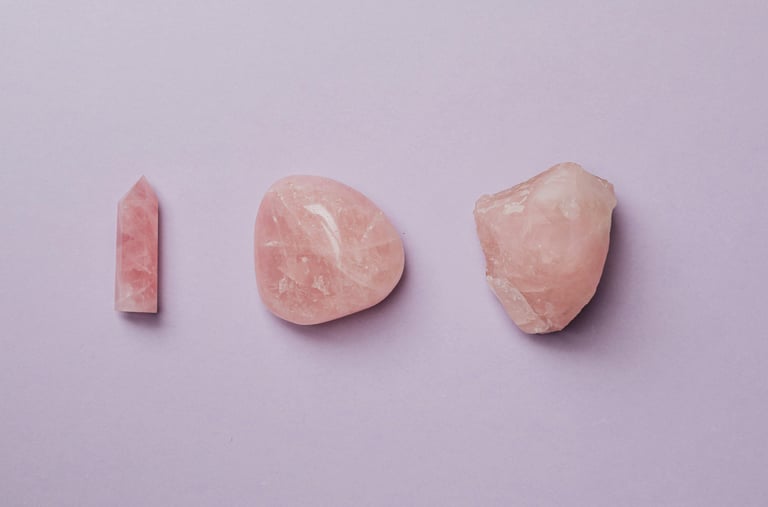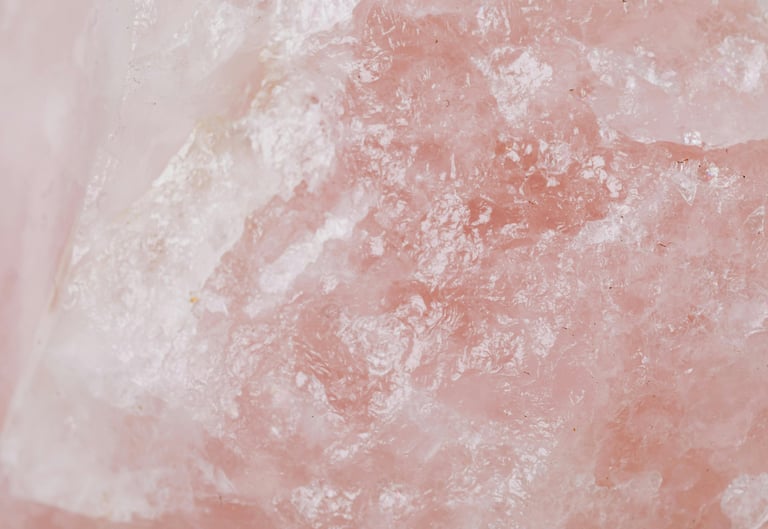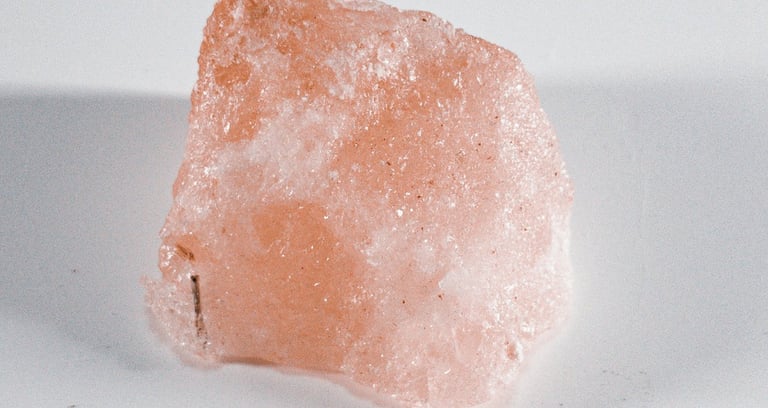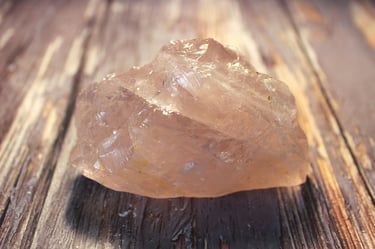Rose Quartz
Unconditional love, emotional healing & stability, compassion, nurturing energy, peace, stress relief, self-love, & forgiveness.
Metaphysical Properties:
Rose Quartz is known as the “Stone of Unconditional Love” and is one of the most popular crystals used for promoting emotional healing, compassion, and nurturing energy. It enhances love, compassion, and empathy. Rose Quartz encourages the healing of emotional wounds, and promotes a sense of calm and comfort.
Symbolism & Associations:
Rose Quartz is closely linked with love, healing, peace, and emotional tranquillity. It represents the unconditional love that flows within our hearts, and it encourages feelings of warmth, caring, and acceptance.
Chakra Alignment:
Rose Quartz aligns primarily with the Heart Chakra. Promotes love, compassion, and emotional healing. Cultivates self-love, forgiveness, and deeper connections.
Planets:
Venus
Zodiacs:
Taurus, Libra
Elements:
Earth, Water
Similar Stones:
Rhodonite, Aventurine, Pink Calcite, White Quartz
Correspondences:
Colours: Soft pink, light rose, and pastel tones.
Crystals: Amethyst, Rhodonite, Aventurine, Carnelian.
Flowers: Roses, Peonies, Lavender.
Herbs: Rosemary, Lavender, Chamomile.
Essential Oils: Rose, Geranium, Ylang-Ylang, Lavender.
Incense: Rose, Jasmine, Sandalwood.
Metals: Copper, Silver.
Months, Days, & Seasons: January, February, Friday, Sunday, Spring, Summer




Facts
Stone Type:
A type of Quartz that is known for its soft pink hue. Found in massive, translucent or opaque forms, sometimes cloudy.
Hardness Rating:
7 on the Mohs scale, so suitable for everyday wear.
Chemical Formula:
SiO₂ (Silicon Dioxide) with trace amounts of Titanium and Manganese, giving it its pink colouration.
Care Guide
Rose Quartz is relatively durable but should be treated gently to avoid scratches or chips. It can be cleaned with warm, soapy water or a soft cloth. Avoid using harsh chemicals or ultrasonic cleaning methods, as they could damage the surface.
Spiritual
Often used in meditation to open the heart, promote deep emotional healing, or to forgive oneself and others. It is a powerful stone for helping one connect with universal love and is believed to enhance the energy of love, compassion, and kindness in one's life.
Healing
Rose Quartz is believed to promote physical healing, particularly in relation to the heart and circulatory system. It is used to reduce stress, improve sleep, and ease tension in the body. Some believe it can help lower blood pressure, heal heart conditions, and even improve skin health by promoting love and emotional peace.
Cleansing
Rose Quartz can be cleansed with water or by placing it under the moonlight to recharge. It is also beneficial to clear it using sound vibrations or a sage smudge, especially after emotional healing work or when it has been exposed to heavy energy.
Affirmations
“I open my heart to love and healing.”
“I am worthy of love and affection.”
“I forgive myself and others, releasing all emotional pain.”
“Love flows freely through me, bringing peace and balance into my life.”
Meditation
Visualize a soft pink light expanding from the heart chakra. Picture the light surrounding you with love and compassion, gently healing emotional wounds. As you breathe deeply, allow negative emotions to dissolve, replaced by a sense of peace and unconditional love.
Astrology
Most commonly associated with Taurus and Libra, both ruled by Venus. These signs benefit from Rose Quartz’s soothing energy, as it supports their emotional well-being, self-love, and romantic relationships. It also brings peace and harmony to these signs, helping them find balance and calm in their lives.
Vibration
Rose Quartz vibrates at a gentle, loving frequency. Its energy is calming, nurturing, and healing, offering support to those dealing with grief, emotional pain, or relationship challenges. Its vibration helps to heal emotional wounds.
Did You Know:
Rose Quartz is often referred to as the "Love Stone" because of its powerful properties in attracting love and promoting emotional healing. It has been used for centuries in different cultures for its ability to nurture the heart and provide comfort to those who are grieving or recovering from emotional distress.


Mythology & Folklore
Rose Quartz has been revered in many ancient cultures for its deep connection to love, beauty, and harmony. Ancient Egyptians believed that the stone could prevent ageing, and they often used it to create beauty masks. They associated Rose Quartz with the goddess Isis, who was seen as the goddess of love, magic, and healing. It was thought that Rose Quartz's gentle energy could slow the ageing process and enhance beauty by infusing the user with love and self-compassion.
In Greek mythology, the stone is said to have originated from the god Eros, who is often depicted as the god of love and desire. It is said that Eros gave the stone to his beloved Psyche as a symbol of his everlasting love, hence linking Rose Quartz to deep, passionate connections and emotional bonds. The myth suggests that the stone's energy is a reflection of true love, romantic affection, and the union of hearts.
In ancient Rome, the stone was thought to be a powerful tool for securing the affections of others. It was often given as a gift between lovers to strengthen their bonds, and was used in rituals to attract new love and to heal heartache. The Romans used Rose Quartz in their love rituals, believing it would help open the heart and bring emotional healing.
Throughout the ages, Native American tribes also valued Rose Quartz for its association with unconditional love and peace. They believed that the stone had healing properties, especially for emotional wounds caused by heartbreak or grief. Some tribes used Rose Quartz as a symbol of peace, gifting it to others as a token of friendship and compassion.
In medieval Europe, Rose Quartz was thought to have protective properties. It was often used as an amulet against jealousy and negative emotions, helping to foster inner peace and harmony. It was believed that the stone could calm tempers and strengthen bonds in relationships, making it a powerful tool in both romantic and platonic connections.
Today, Rose Quartz continues to be seen as a symbol of love, compassion, and emotional healing. Its deep connection to the heart chakra and its history as a stone of love across many cultures has cemented its place as one of the most cherished and versatile crystals in the metaphysical community.
Historical Significance
Rose Quartz has a long history as a stone of love, beauty, and healing, valued by many ancient civilizations for its perceived ability to bring peace, emotional healing, and harmony into the lives of those who used it. The stone's soft pink hue made it a highly desirable gemstone in both jewellery and ritual objects, with a history that stretches back thousands of years.
In Ancient Egypt, Rose Quartz was highly prized for its ability to promote physical and emotional well-being. The Egyptians believed that the stone had powers of regeneration, youth, and beauty, and it was often used in facial masks and cosmetics. They believed that the stone could prevent the signs of ageing, keeping the skin smooth and youthful. Rose Quartz was also used in the creation of amulets and talismans, worn by both men and women to protect them and attract love and positive energy.
In ancient Rome, Rose Quartz was used in a similar fashion. The Romans valued Rose Quartz for its associations with love and beauty, often using it in jewellery and as a gift between lovers. It was said that wearing Rose Quartz would increase one's ability to attract love and affection, and the stone was often exchanged as a token of affection or commitment. It was also considered to be a symbol of fidelity and devotion.
In China, Rose Quartz was believed to have the power to bring harmony into one's life, and it was often used in carvings and jewellery. The stone was prized for its healing properties, particularly in terms of emotional healing, and it was thought to open the heart chakra and soothe negative emotions. Rose Quartz was also used to treat heart conditions, as it was thought to improve circulation and promote balance in the body. Over the centuries, Rose Quartz was crafted into beautiful ornamental pieces, including figurines, vases, and pendants.
During the Middle Ages, Rose Quartz became a symbol of peace and reconciliation. It was used as an offering during peacemaking ceremonies, where it was believed to heal emotional wounds and restore balance and understanding between parties in conflict. The stone was also thought to have protective qualities, shielding its wearer from envy, jealousy, and negative emotions.
In more recent history, Rose Quartz continued to be valued, especially in the metaphysical community. By the 19th century, Rose Quartz became a popular material for jewellery, particularly in Europe and the United States, where it was carved into cameos, cabochons, and beads. The stone was believed to hold the energy of love and compassion, and it was used in spiritual practices to bring emotional healing and balance.
Today, Rose Quartz remains one of the most beloved and widely-used stones in both metaphysical and mainstream contexts. Its historical significance as a symbol of love, peace, and healing has not only endured but has also evolved to include its use in modern healing practices such as crystal therapy, meditation, and energy healing.
Origin & Formation
Rose Quartz is a variety of quartz that is typically found in a soft pink to reddish-pink hue. Its unique colour is attributed to the presence of trace elements like titanium, iron, and manganese within its crystal structure. The exact cause of its pink colouration remains a topic of scientific debate, but it is believed that these elements, along with certain processes occurring during the stone's formation, create the characteristic pink tones of Rose Quartz.
Rose Quartz is commonly found in pegmatitic rocks, which are coarse-grained rocks formed from the slow crystallization of magma. These types of rocks, where Rose Quartz is most often found, are rich in large crystals and often contain other minerals like feldspar and mica, which are also present in some varieties of quartz.
The primary deposits of Rose Quartz are located in Brazil, Madagascar, and the United States (specifically in South Dakota and North Carolina), where large quantities of the stone have been mined for centuries. Additionally, significant deposits can also be found in India, Sri Lanka, Myanmar, China, and Tanzania.
The stone forms when silica-rich solutions (which are often present in groundwater) seep into cracks in the host rock. Over time, these solutions become concentrated, and the minerals crystallize within the fractures, forming Rose Quartz crystals. The formation process takes millions of years, with the crystals growing slowly within the host rock before being unearthed by natural processes like erosion or excavation.
Rose Quartz typically forms as large, opaque masses of the mineral, with crystals that are usually too fine-grained to be seen with the naked eye. The stone may also form in veins or nodules embedded in the surrounding rock, and it is often found in association with other quartz varieties like Clear Quartz, Amethyst, and Smoky Quartz.
The durability of Rose Quartz is one of the reasons it is so popular in jewellery, as it can withstand normal wear and tear while maintaining its vibrant colour. Its formation process means that Rose Quartz can come in many different shapes, including rough crystals, polished stones, and tumbled pieces, each showing unique variations in colour and clarity.
Variation & Quality
Rose Quartz, primarily known for its delicate pink colour, can vary in shade, transparency, and appearance. The most sought-after Rose Quartz has a soft, even pink hue, free of inclusions or noticeable variations. However, the colour can range from pale, almost white-pink to deeper, richer rose-pink tones, and stones with darker hues are often considered more precious.
The transparency of Rose Quartz can also vary; some stones are almost opaque, while others are more translucent, allowing light to pass through the material. The more transparent varieties are often cut and polished into fine gemstones, though the opaque versions are equally popular in carvings, spheres, and decorative items.
One particularly rare and visually striking form of Rose Quartz is Star Rose Quartz, which exhibits a star-like figure on its surface when viewed under direct light. This phenomenon is caused by rutile inclusions (thin needle-like crystals) within the Rose Quartz that reflect light in a way that creates a star-shaped figure, typically with four or twelve rays. The inclusion of rutile may affect the clarity of the stone, but it enhances its metaphysical properties and is often seen as increasing the stone's spiritual significance.
Another variation is Pink Quartz, sometimes used interchangeably with Rose Quartz, though it can occasionally have a more peach or coral tone due to trace minerals. These are often clearer and more transparent than traditional Rose Quartz and are sometimes mistaken for a different variety of quartz.
In addition to these colour and clarity differences, Rose Quartz may sometimes have brown, red, or even gold inclusions. These occur due to the presence of iron or other minerals during the formation process and are often seen as enriching the energy of the stone, offering a more grounding or protective quality.
Rose Quartz that has inclusions of white or cloudy areas often has a milky appearance. This does not diminish the stone’s value but is viewed as part of the natural beauty of the stone. Some believe that this cloudy appearance enhances the stone’s energy of unconditional love, as it symbolizes purity, calmness, and clarity within the heart chakra.
Notes
Rose Quartz is often referred to as the “love stone,” but its influence extends beyond romantic relationships. It is also associated with self-love, forgiveness, and emotional healing, making it ideal for those looking to release negative feelings or grief. This stone is widely used in healing and therapeutic practices, not just for love, but also for improving personal well-being, especially in matters of the heart and emotional balance.
It is a popular stone in the creation of jewellery, including necklaces, bracelets, and rings, not just for its metaphysical properties but also for its gentle, soothing colour. Rose Quartz is often seen in crystal grids designed for love and relationships, as well as in spaces intended for meditation and relaxation.
Although it is soft on the Mohs scale (7), making it somewhat prone to scratching, Rose Quartz is still a durable stone when handled with care. As such, it's often recommended for jewellery or decorative pieces but should be kept away from harsh chemicals or abrasive materials to preserve its beauty.
In some cultures, Rose Quartz has been linked to fertility and is believed to have been used as an amulet in ancient times. Its association with the heart chakra makes it a favoured choice for those looking to heal emotional wounds or build stronger, healthier relationships with themselves and others.
This stone is also one of the most commonly used gemstones in metaphysical healing practices and is often placed in the home or on altars to promote peace and harmony. It is said that you should place a Rose Quartz at the doorway of the room, facing in, to enhance and protect relationships.






